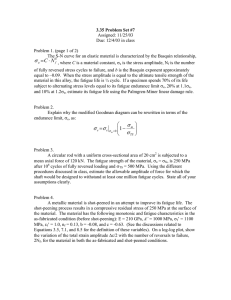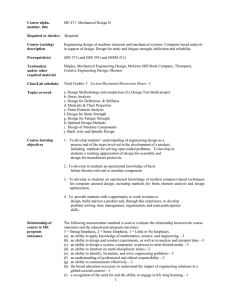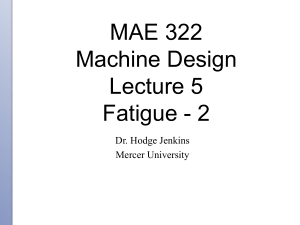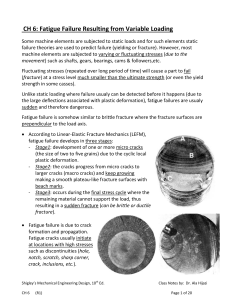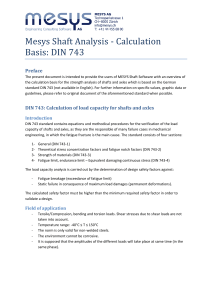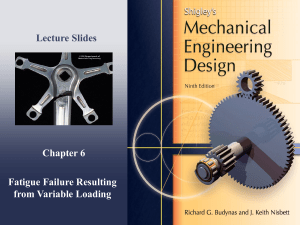While it is always much preferred to use actual values for fatigue
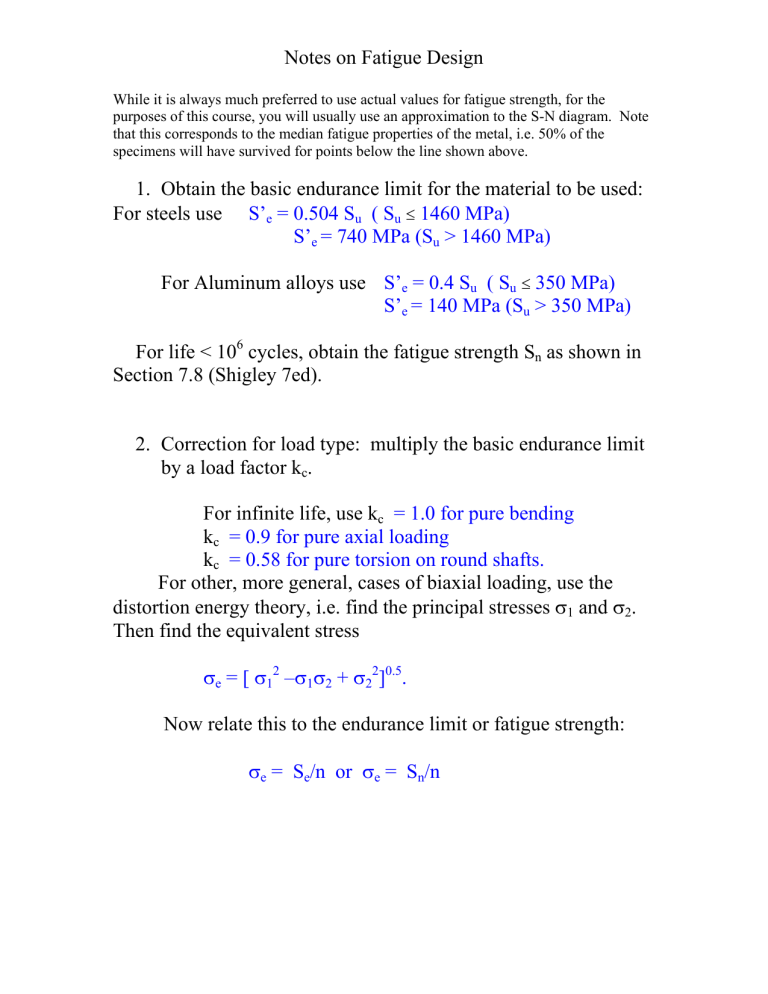
Notes on Fatigue Design
While it is always much preferred to use actual values for fatigue strength, for the purposes of this course, you will usually use an approximation to the S-N diagram. Note that this corresponds to the median fatigue properties of the metal, i.e. 50% of the specimens will have survived for points below the line shown above.
1.
Obtain the basic endurance limit for the material to be used:
For steels use S’ e
= 0.504 S u
( S u
≤ 1460 MPa)
= 740 MPa (S u
> 1460 MPa) S’ e
For Aluminum alloys use S’ e
= 0.4 S u
S’ e
For life < 10 6
( S u
= 140 MPa (S
≤ 350 MPa) u
cycles, obtain the fatigue strength S
Section 7.8 (Shigley 7ed).
> 350 MPa) n
as shown in
2.
Correction for load type: multiply the basic endurance limit by a load factor k c
.
For infinite life, use k c k c
= 1.0 for pure bending
= 0.9 for pure axial loading k c
= 0.58 for pure torsion on round shafts.
For other, more general, cases of biaxial loading, use the distortion energy theory, i.e. find the principal stresses σ
Then find the equivalent stress
1
and σ
2
.
σ e
= [ σ
1
2 – σ
1
σ
2
+ σ
2
2 ] 0.5
.
Now relate this to the endurance limit or fatigue strength:
σ e
= S e
/n or σ e
= S n
/n
Notes on Fatigue Design
3.
Surface finish correction: obtain a surface finish factor k a from Table 7.4 in the text. Note that this is for steels only.
For the purposes of this course only , you may use this data for Al alloys also.
4.
Size effects: apply a size factor k b k b
given by –
= 1.0 for pure axial loading and, k b
= 1.24d
-.107
k b
= 1.51d
-.157
(2.79 d ≤ 51 mm)
(51 < d 254 mm)
Both of the above apply strictly only to fully reversed rotating bending or torsion of round shafts. For other situations, you may use an equivalent diameter d e
in the above relations:
For a rectangular section in bending, use d e
= 0.808 √ hb where h,b are the height and breadth of the section.
For a circular section in non rotating bending, use d e
= 0.370
d where h,b are the height and breadth of the section.
5.
Reliability factor k e
: the above values for fatigue strength are all for the median life, i.e. a reliability of 50%. This is clearly not useful for design. Use the following factors to correct Se’ for the desired reliability value:
Reliability k e
90% 0.897
95% 0.868
99% 0.814
99.9% 0.753
99.99% 0.702
Notes on Fatigue Design
6.
In summary you can obtain the actual endurance limit S e
at a specific location on a specific component by multiplying the basic endurance limit Se’ by the above factors:
S e
= k a k b k c k e
S e
’
The temperature factor k d temperatures.
may be taken as 1.0 for normal
7.
Stress concentrations: first get the static stress concentration factor k t
from published charts or tables.(see Table A.15 in
Shigley 7ed.)
Then find q from Figures 7.20 and 7.21 in Shigley 7ed.
Get k f
= q(k t
– 1) + 1 Note that you may have to get different factors for different combined loads such as bending and torsion. Apply each factor to the appropriate component. It is common to only apply the k f components σ xa
, σ ya
and τ xya values to the alternating stress
.


